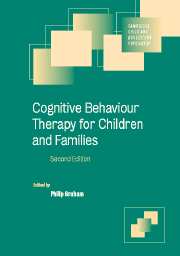Book contents
- Frontmatter
- Contents
- List of contributors
- 1 Introduction
- Part I Developmental cognitive theory and clinical practice
- Part II Engagement and assessment
- Part III Client groups
- 7 Working with parents: some ethical and practical issues
- 8 Cognitive behaviour therapy with prepubertal children
- 9 Cognitive behaviour therapy in inpatient environments
- Part IV Applications in psychosocial adversity
- Part V Applications in specific child and adolescent psychiatric disorders
- Part VI CBT applications in preventive interventions
- Index
- References
7 - Working with parents: some ethical and practical issues
Published online by Cambridge University Press: 21 August 2009
- Frontmatter
- Contents
- List of contributors
- 1 Introduction
- Part I Developmental cognitive theory and clinical practice
- Part II Engagement and assessment
- Part III Client groups
- 7 Working with parents: some ethical and practical issues
- 8 Cognitive behaviour therapy with prepubertal children
- 9 Cognitive behaviour therapy in inpatient environments
- Part IV Applications in psychosocial adversity
- Part V Applications in specific child and adolescent psychiatric disorders
- Part VI CBT applications in preventive interventions
- Index
- References
Summary
Introduction
While there have been increasing attempts to respond to Kendall's call to ‘unravel the role of parental involvement in the outcome of child therapy’ (Kendall, 1994), there is still little solid research evidence to guide clinicians as to how best involve parents in cognitive behavioural therapy (CBT) for children and young people. It has been suggested that parents can be conceived as being involved in CBT with their children in three broad possible roles: facilitator, co-therapist or client (Stallard, 2002b). What research literature there is suggests that involving parents in one or more of these roles may be beneficial in the short-to-medium term for a range of presenting problems, and particularly for younger children, although the long-term gains are less clear (Barrett et al., 1996; Fonagy et al., 2002).
The majority of the literature on CBT for children and young people continues to reflect its ‘adult’ roots in terms of its primary focus on individual work with children themselves. While recent works have stressed the need to adopt a systemic perspective (e.g. Friedburg and McClure, 2002; Stallard, 2002a) there has been little detailed discussion of how this might be achieved. Moreover, there has been little examination of what factors need to be taken into account when determining the nature and extent of parental involvement, how parental roles might be negotiated and agreed with the parents themselves or how wider or more complex family issues might be addressed.
- Type
- Chapter
- Information
- Cognitive Behaviour Therapy for Children and Families , pp. 103 - 120Publisher: Cambridge University PressPrint publication year: 2004



